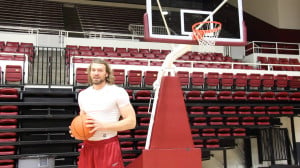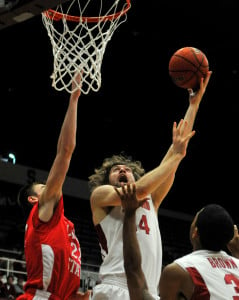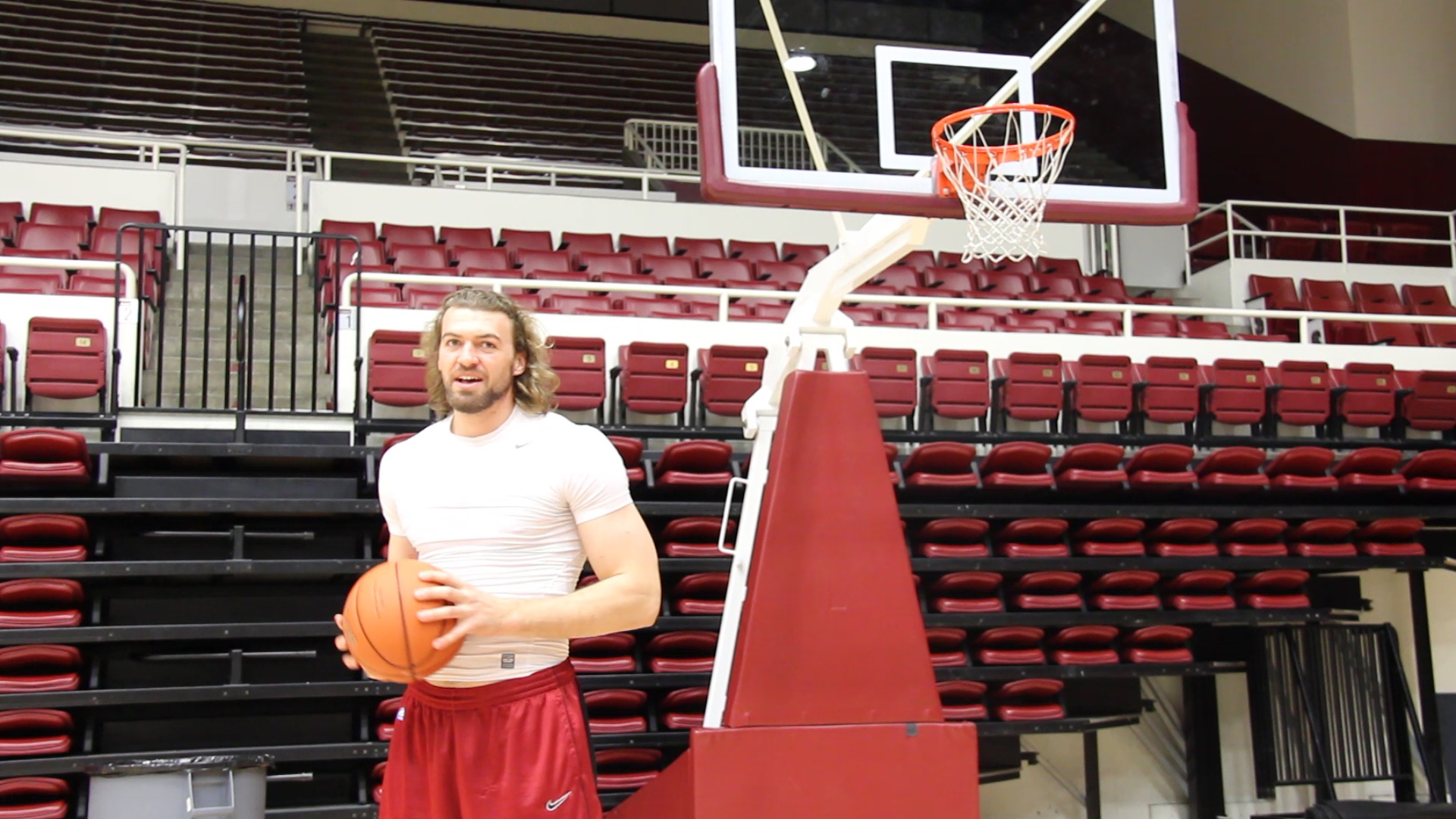Fans of the Stanford men’s basketball team may have spotted a couple of all-too-familiar faces in the student section this year. Towering above most of the rest of the Sixth Man Club, two of last year’s NIT-winning stars, Andrew Zimmermann ‘12 and Jack Trotter ‘12, have been not-so-quietly making their presence felt. Intrigued by the role reversal of athlete-turned-fan, I sat down with Zimmermann last week to learn the full story.
In an interview last year, Zimmermann explained that though he hoped to eventually study for both an M.D. and MBA, he wasn’t quite ready to give up on basketball. His plan after graduation was to head off overseas and play perhaps in Europe or Japan for a couple of seasons before returning to school.
Those plans, though, had to be put off when Zimmermann developed an injury towards the end of his junior year. He suffered cartilage tears in both hips that made training and playing progressively more painful, but he was reluctant to have an operation to fix the problem immediately.
“I chose not to have surgery after my junior year because the best-case scenario was a six-month rehab [and] the worst-case scenario was a year, and so I figured I would just try to manage the injury,” said Zimmermann. “That went well until about halfway through the season my senior year… and by the end of the season I had to sit out a couple of games because it was difficult walking, it was difficult running.”

Luckily for Zimmermann, though, he was able to stay on for an extra year at Stanford — not as a student, but as a researcher in the School of Medicine — allowing him to keep in touch with the physical therapists and trainers on the basketball team and get the best possible rehab. Seven months out from the last of two operations, he played his first game of five-on-five basketball in the last couple of weeks and is on track to head overseas later this year.
Exactly where he’ll end up, and what team he’ll end up playing for, is, though, still undecided.
“At the end of the day, it’s what you’re willing to play for,” said Zimmermann. “I’m not positive I’ll find the perfect situation, just because I’m coming off of injury, but we’ll see. And if the perfect situation doesn’t arise, then maybe it’s time to call it quits and say, ‘Well, I’ve put everything into it, but it’s just not meant to be.’”
Whenever Zimmermann does decide to finally hang up his boots, he plans to make a career in medicine, possibly seizing the Bay Area startup bug and exploring medical entrepreneurship. This last year he has been working as a life science research assistant in Stanford’s School of Medicine, but even before graduating last June he had already been gaining considerable experience in his chosen field.
Zimmermann had a rather unusual route to the Farm, by way of first Santa Clara and then Foothill College. So when he finally made it to his senior year at Stanford, he needed just once more class to graduate with a degree in biology. However, NCAA rules required that he still register for at least 12 units of coursework, so Zimmerman spent most of his final year working in a plastic surgery laboratory investigating wound regeneration.
Talking about his longer-than-usual college career, Zimmermann had no regrets.
“I wouldn’t change it,” Zimmermann said, “and it’s just one of those things that probably helped me grow along the way, deal with some adversity, kind of mature to be able to do what I did when I came to Stanford.”
He was originally recruited by Santa Clara head coach Dick Davey, but by the time he had made the trip out from his home town of Oostburg, Wisc., Davey had retired. Zimmermann did not see eye to eye with the new setup at Santa Clara and started just one game in a frustrating freshman year.
“There’s a lot that went on behind the scenes, good for him [Davey], bad for him,” said Zimmermann. “The whole situation was a lot more messy than what was portrayed. It was disappointing for sure, because he came out and recruited me. I really liked him; my parents really liked him. I really felt good about him being my coach.”
When Davey then took up an associate head coaching position with Stanford’s newly appointed head coach, Johnny Dawkins, his and Zimmermann’s paths would finally cross again, though not immediately. Zimmermann transferred to Stanford at the end of his freshman year, but because he was not immediately released by Santa Clara, he could not receive a scholarship to come to the Farm straight away. He instead opted to spend a year at Foothill College, staying in touch as much as possible with the basketball program and training with the team over the summer.
Zimmermann may have started his collegiate career as a Bronco, but it is clear that Stanford has now won his heart.
“The Cal game last year at home was great,” said Zimmermann. “They came in, they had to beat us to tie for the championship and to be able to take that from them, being our rivals, was pretty awesome.
“It’s serious,” continued Zimmermann about the rivalry. “There’s a lot of guys on the team I don’t like. It’s funny ‘cause I’m sure if I played with them I’d be buddy-buddy with them, they’d probably be cool and I’m sure they think the same about us.”

He likens himself to ex-Cal player Jorge Gutierrez, someone opposition fans loved to hate, and it’s easy to see why. Standing at 6-foot-8 and weighing in at 230 pounds, Zimmermann stood out from the rest of the clean-cut Cardinal last year with a shaggy mane of hair and scruffy beard that matched his on-court persona.
“After my junior year, they kept bringing up Matt Howard from Butler,” Zimmermann said. “How he just plays hard, he doesn’t care what people think of him. He had the crazy hair, unkempt. He had baggy socks, and he just had a game that just showed that he didn’t care what other people thought. He was going to play how he played.”
The clean-shaven Dawkins turned a blind eye to Zimmermann’s new look, perhaps because it matched his forward’s approach to every minute of every contest.
“You hear those people who say they’d run through a brick wall,” said Zimmermann. “Well, I felt that that was kind of who I was, and then my goal was to get everybody to have that same kind of passion and fire and work ethic and enthusiasm. So when we stepped out onto the court, teams saw that this is who Stanford is, we’re not the smart, educated, soft team. We’re smart and educated, and we’re also willing to run through a wall.”
Though he is no longer on the team and can no longer inspire from the hardwood, Zimmermann has not relinquished his motivating role. Chest painted, caveman look still in full swing, jumping up and down and yelling at the opposition, he has instead become one of the most visible members of the student group that used to cheer him on from the sidelines, Stanford’s Sixth Man Club.
“I remember watching Stanford games, the Sixth Man used to be one of the best student sections in the country,” Zimmermann said. “I did everything as an athlete at Stanford to try and build the basketball program, and I figured while I’m here, lets see what I can do to help get the student section back to the prestigious level it was.”
In Zimmermann, the team, and the university as a whole, has a fan that has clearly been drinking the Stanford Kool-Aid.
“I’m a big proponent of supporting each other as athletes,” said Zimmermann, “but even going to theater performances… different musical events, dance events. That’s just the thing about Stanford, there are so many amazing opportunities [that] sometimes you don’t realize how many things you could do, or it’s overwhelming to think, ‘Today there’s a soccer game, a baseball game and a volleyball game, and I have homework.’”
He also knows much more intimately than most both what it is like to be on a college basketball team and exactly how much work and determination the current players put in not just at game time but behind the scenes in practice. Frustrated as he might be by losses and poor performances, it’s a unique relationship for any fan to have with his team and something that makes it much harder to criticize coach or players.
But perhaps after his sojourn overseas Zimmermann could be tempted to do something a bit different. Davey praised his player’s coaching abilities in an interview last year, and Zimmermann has been trying his hand at coaching kids at Saratoga and Los Altos high schools and helping with a basketball program in East Palo Alto. Could Zimmermann one day make it back to Maples Pavilion to trade in his player and fan roles for something rather different?
Contact Tom Taylor at tom.taylor “at” stanford.edu.
